To say one country encapsulates the world’s largest continent is quite the claim, yet the “Malaysia, Truly Asia” tourism slogan lives up to the hype. But what no tagline could capture is the sheer vibrancy of this multicultural peninsula, where worshippers pray in temples dotted between towering skyscrapers, while mischievous “mafia” monkeys prey on unwitting tourists (of which more later).
Why you should visit Malaysia
Set at the meeting point between the South China Sea and the Indian Ocean, Malaysia has been dubbed “Asia’s Melting Pot”. Following centuries of trade and colonisation, the population comprises three main ethnic communities: Chinese, Indians and Malays.
For a concentrated taste of the resulting rich cultural stew, head to Kuala Lumpur. The world’s sixth most visited city last year, the Malaysian capital is a chaotic blend of sleek hotels and crumbling colonial-era buildings, Michelin-starred restaurants and street-food stands, upmarket malls and outdoor markets, plus world-famous sights such as the Petronas Twin Towers.
Sign up for The Week’s Free Newsletters
From our morning news briefing to a weekly Good News Newsletter, get the best of The Week delivered directly to your inbox.
From our morning news briefing to a weekly Good News Newsletter, get the best of The Week delivered directly to your inbox.
Kuala Lumpur is also home to some great green spaces, but to experience Malaysia’s tropical rainforests and golden beaches, you’ll need to go a little further afield. An hour from the capital by plane is Langkawi, an archipelago of 99 islands along the country’s northwest coast. The main island, also called Langkawi, is home to around 100,000 people, whose numbers are being bumped up by a growing stream of tourists.
Langkawi’s mangrove forests cover more than 3,000 hectares (7,400 acres)
(Image credit: Marriott International)
Yet Langkawi is not over-developed: it was awarded Unesco Global Geopark status in 2007, prompting a push towards geotourism. The local tour guides have plenty of material to work with in the island’s ancient jungles and labyrinth of mangroves housing sea caves and millions-year-old rock formations.
And then, of course, there’s the wildlife. The island is named after the reddish-brown (kawi) sea eagles (lang) that dominate the skies above. Other, less obvious, predators to watch out for are Langkawi’s gangs of long-tailed brown macaques, nicknamed the “monkey mafia” by locals owing to their habit of snatching not only food but also phones. A tip for targeted tourists: offer the gangster macaque food with both hands to make them drop the loot.
What to see and do
Assuming visitors hang on to their phones, both Langkawi and Kuala Lumpur are packed with Instagram-worthy sights.
The capital also has plenty to offer nature lovers, who can find tranquillity in the 227-acre Lake Gardens in the heart of the city. A short stroll away is Kuala Lumpur’s Bird Park, an enclosed aviary of more than 3,000 birds from more than 200 species. And there are more attractions to get visitors’ hearts aflutter at the neighbouring Butterfly Park, billed as the world’s largest, with more than 5,000 butterflies.
Kuala Lumpur claims another record with the Petronas Twin Towers, the world’s tallest twin skyscrapers at 1,483ft (452 metres). The towers’ Observation Deck offers unbeatable views of the city’s eclectic architecture and neighbourhoods, each of which have a distinctive vibe.
Among the most atmospheric is Brickfields, aka Little India, a colourful maze of shops and stalls selling saris, spices, flower garlands and more, amid packed temples, churches and mosques. There are plenty of opportunities to feed body as well as soul here too, at low-key restaurants serving high-quality food including Malaysia’s national dish, nasi lemak, a spicy coconut rice.
Foodies are equally well served on Langkawi, where floating fish farms double as restaurants where diners can select their still-flapping meal from containment nets and aquariums. These fish farms are popular stopping points on mangrove river cruise tours, an unmissable experience for any visitor.
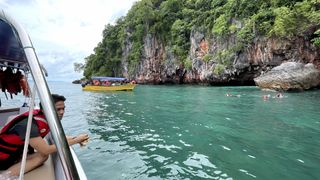
Mangrove cruises on the Kilim River are a great way to spot wildlife and learn about this delicate ecosystem
(Image credit: Marriott International)
Highlights of a cruise through Kilim Karst Geoforest Park, one of the island’s three main conservation areas, include hand-feeding stingrays and exploring limestone caves where hundreds of bats hang overhead (visitors are advised to close their mouths when looking up, to avoid an unwanted feeding of droppings).
Expert guides also help cruise-goers to get up close – but not too close – to the park’s many other inhabitants, from crocodiles and kingfishers to otters and snakes. And visitors can do their bit to help with conservation efforts by planting mangrove trees, which can store up to 10 times more carbon than forests.
Slightly less virtuous but just as unmissable is a sunset cruise around the archipelago. Guests can sip cocktails and cool off from the tropical heat in the bath-temperature Andaman Sea. Along with water sports, there is further entertainment to be had watching local fishermen’s dogs living their best lives after swimming to nearby island shores for doggy playdates.
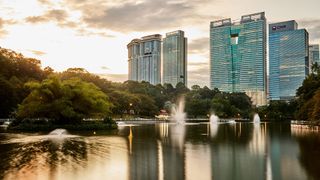
The St. Regis Kuala Lumpur sits amid skyscrapers besides the city’s largest park, the Lake Gardens
(Image credit: Marriott International)
Where to stay
Tourists also looking to live their best lives in Malaysia can get off to the right start by checking into a St. Regis hotel.
Offering grandeur with a great location, the St. Regis Kuala Lumpur overlooks the Lake Gardens in the Sentral district, a key transportation hub. In a nod to the city’s multicultural identity, the 48-storey hotel blends Asian aesthetics with art deco style, with acres of gleaming marble and crystal-chandeliered high ceilings.
Those high ceilings are a boon come sunset, when, as in all St. Regis properties, a daily champagne sabring ritual takes place. Inspired by Napoleon Bonaparte, who opened bubbly with his sabre in both victory and defeat, the hotel’s bottle-chopping fun offers guests the chance to enjoy a free drink and even have a go at sabring. Though, presumably, only while sober.
The ritual is one of a series introduced by the St. Regis chain founder John Jacob Astor IV, who later went down with the Titanic. Astor’s other innovations include a 24-hour butler service tailored to meet guests’ every need, from unpacking luggage to delivering a morning cuppa.
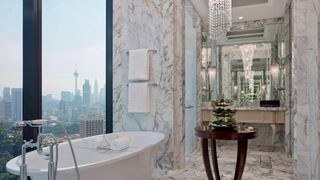
The hotel’s suites and bathrooms have stunning views over Kuala Lumpur
(Image credit: Marriott International)
The rooms are equally top-notch, with floor-to-ceiling windows and mod cons including hi-tech toilets with an electronic bidet and seat warmer (don’t knock it till you’ve tried it). On a more high-brow note, the hotel’s attractions also include an impressive collection of artwork by big names including Andy Warhol and Terry O’Neill.
Food is another draw at the St. Regis Kuala Lumpur, which is home to seven restaurants and bars, including a sushi joint overseen by three Michelin-starred chef Takashi Saito.
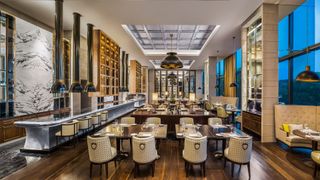
The Brasserie has a French cafe vibe and a superb menu that blends vibrant European and Malaysian flavours
(Image credit: Marriott International)
The hotel’s largest restaurant is The Brasserie, which along with French-Mediterranean cuisine, serves an incredibly extensive buffet breakfast. Possibly the only thing not on the menu is durian, an extremely pungent Malaysian fruit that is banned in most public buildings.
Only the sweetest of smells can be scented at the hotel’s spa, where bespoke massages are a great way to relax after a stint in the rooftop pool or adjacent gym. With all these facilities, little wonder that some people decide to stay for good: while the hotel’s first 21 storeys house 208 guest rooms, those above are filled with residences inhabited by permanent “guests”, including families with pets.
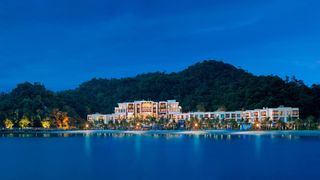
The St. Regis Langkawi hugs the turquoise Andaman Sea
(Image credit: Marriott International)
Sadly for visitors considering selling up back home, no residency options are available at the St. Regis Langkawi. But few will forget a stay at this idyllic island retreat, tucked between rainforest and the sea, a short drive from Langkawi’s main town, Kuah.
The vibe throughout the hotel is laid-back glamour, with grand, light-drenched spaces full of local artworks, and colour schemes influenced by the sea and the island vegetation.
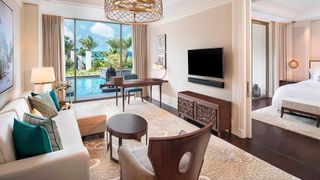
Suites at the beachside hotel are havens of luxury and comfort
(Image credit: Marriott International)
Those themes continue in the 85 spacious suites and in Kayuputi, a fine-dining restaurant standing on stilts above the water beside the hotel’s private beach. Designed by top architect Bill Bensley, Kayuputi (“white wood” in Indonesian) is like the world’s plushest beach hut, with teak columns and antiques galore inside, and an outdoor deck that’s the perfect setting for sunset cocktails.
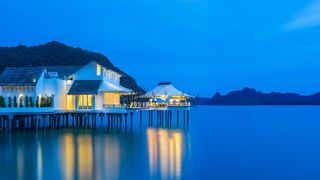
The Bill Bensley-designed Kayuputi restaurant is evocative of an art collector’s holiday home
(Image credit: Marriott International)
Come morning, the place to be is the hotel’s all-day dining restaurant L’Orangerie, where the St. Regis team again score top marks with the vast breakfast buffet.
For a quintessentially island experience, though, nothing beats the beachfront Pantai Grill. With platters of succulent charcoal-grilled meats and seafood served at tables on the golden sand, this is how barbecues are meant to be done.
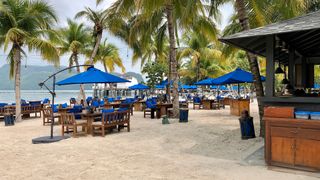
Diners can enjoy delicious wood-fired food only metres from the shore at Pantai Grill
(Image credit: Marriott International)
The St. Regis Langkawi also provides a lesson in meeting guests’ many other wishes, with a hair salon, spa, gym, boutique and ballroom, plus live music every evening in the bar. A host of activities are on offer too, from paddleboarding and kayaking to wine tasting and batik painting.
Of course, some guests may prefer to just relax in the seafront infinity pool. But as with Malaysia in general, the beauty lies in the “endless possibilities”, to quote another of the country’s tourism slogans. Just watch out for the monkeys.
Kari Wilkin was a guest of the St. Regis Kuala Lumpur and the St. Regis Langkawi
Room rates start from £176/$223 (double room) at the St. Regis Kuala Lumpur, 6, Jalan Stesen Sentral 2, Kuala Lumpur Sentral, Kuala Lumpur, 50470 Malaysia. Room rates start from £221/$280 (double room) at the St. Regis Langkawi, Jalan Pantai Beringin, Langkawi, 07000 Malaysia. For more information, visit marriott.com
Sign up to The Week’s Travel newsletter for more destination guides and the latest trends

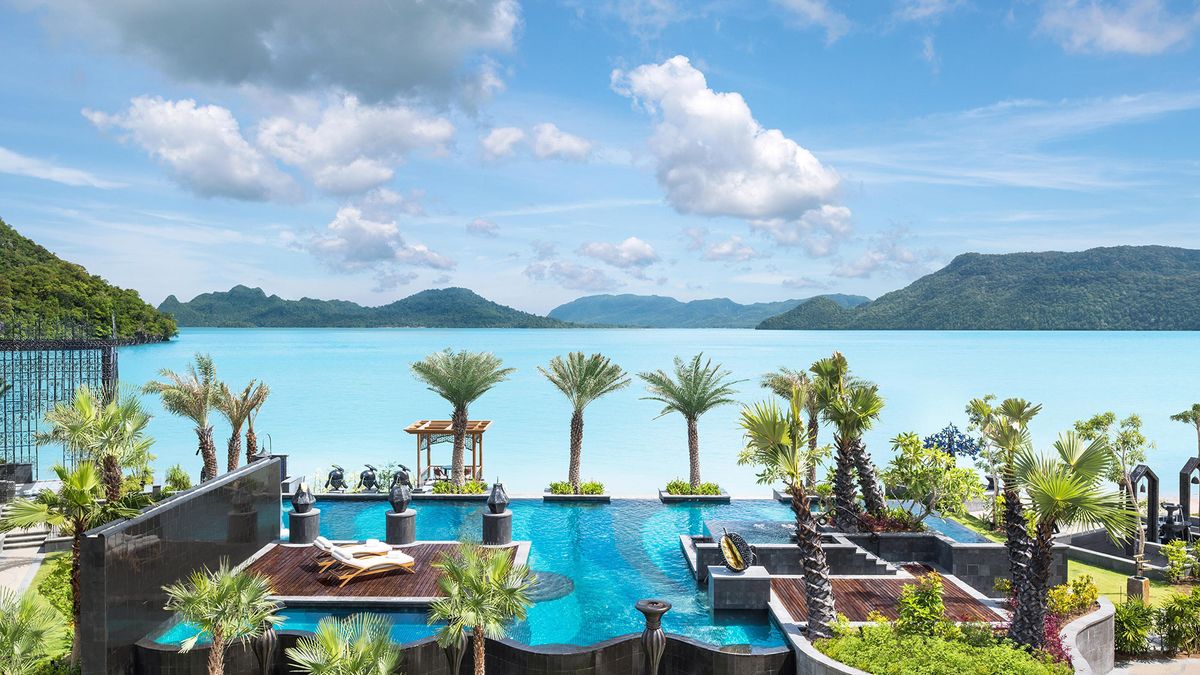






:max_bytes(150000):strip_icc()/roundup-writereditor-loved-deals-tout-f5de51f85de145b2b1eb99cdb7b6cb84.jpg)


